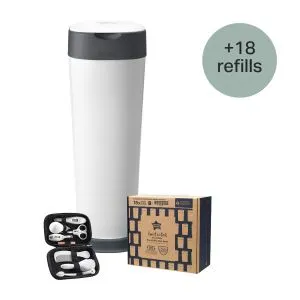
Ultimate XL Nappy Disposal Bundle with 18 Refills
Bundle & Save 40%
Subscription orders can be cancelled at anytime. Free delivery on all subsequent subscription orders. Find out more about subscriptions.
They’re easy and fuss free
Your products are automatically sent to you
You save up to 10% when you sign up for a subscription
You can cancel at any time

Remember that every parent and baby are different, and so is every baby's feeding journey - with some exclusively breastfeeding or formula feeding, and some combination feeding.
If you're looking to learn more about combination feeding, we're here to help. This guide covers everything you need to know before getting started with combination feeding and answers some of the most-asked questions about combi feeding a baby.
Also known as mixed, combi or partial feeding, combination feeding is when a bottle of expressed breast milk or formula is used to feed a baby alongside direct breastfeeding. Let's run through some of the various approaches to combination feeding:
Explore the Range
Before you begin combination feeding, consider that:
Don't worry too much though. If you start bottle feeding your baby when they're a little older, you're both comfortable with breastfeeding and continue to breastfeed and express using a pump frequently, your breast milk supply shouldn't be impacted.
The WHO and UNICEF recommend exclusive breastfeeding for the first six months of life, and before introducing formula feeds into your baby's routine, you should speak to your health visitor.
Babies should develop a good breastfeeding latch before they're fed using a bottle. However, some parents decide to combi feed their newborn baby from birth. This is safe to do but may make switching between breast and bottle more challenging.
It's recommended that parents wait until their baby is comfortable with breastfeeding before bringing a bottle of breast milk or formula into the mix. You should speak to your health visitor before starting combination feeding.
When you first introduce a bottle:
Although there're lots of benefits that come with combi feeding, using a combination of different feeding methods may be tricky for both a baby and their parents to get used to at first. Let's run through some advice to help you introduce bottle feeding into your feeding journey - whether that's expressed breast milk or formula.
If you'd like to combine breastfeeding with expressed breast milk feeds, you'll need a breast pump to collect your breast milk to give to your baby in a bottle.
Parents often find that when they express breast milk in the morning, they're able to collect more in a shorter amount of time. But it's also worth noting that expressing at night helps to maintain your long-term milk supply, so try to do both if you can.
It's also important that you carry on breastfeeding or expressing regularly from each boob. If you don't, there's a chance that your boobs can become painful and engorged.
The WHO and UNICEF recommend exclusive breastfeeding for the first six months of life, and before introducing formula feeds into your baby's routine, you should speak to your health visitor.
If you'd like to feed formula in a bottle alongside direct breastfeeding, it's recommended that you introduce them to formula gradually. Not only does this give time for your body time to reduce the volume of breast milk it produces, but it also allows your little one's digestive system plenty of time to adjust.
If you're introducing formula feeds because you're going back to work, it can help to start combination feeding a few weeks in advance. Establishing a good combination feeding schedule can help you get into the swing of your new routine.
Combination feeding using formula can reduce the quantity of breast milk you produce. For this reason, you should carry on breastfeeding your little one and expressing using a pump regularly to keep your supply going.
When you're substituting breast milk with formula, it can take up to seven days for the amount of breast milk your body makes to adjust to missing just one feed. So, it's important to gradually reduce breastfeeds and top up breast milk feeds with formula at first to reduce the gaps between breastfeeds.
Additionally, expressing between feeds can help to increase your breast milk supply if you want to return to breastfeeding.
Yes, if you follow safe preparation guidelines, you can give your baby a mix of breast milk and formula in the same bottle.
If you decide to do so, you should follow the manufacturer's instructions exactly when preparing the formula, before adding your expressed breast milk. When mixing formula, never substitute water for your breast milk.
If you're struggling to begin combination feeding, it can help to ask your midwife or health visitor about the best bottle position and breastfeeding attachment methods. These can help ensure your baby doesn't get confused between your nipple and the bottle's teat.
If you still have a good breast milk supply, it's often possible to go back to exclusive breastfeeding. If you decide to do this, try to make the change gradually by offering your breast first and reducing the formula you give your baby.
The more you express, the more you'll make. So, continuing to pump and having plenty of skin-to-skin contact with your little one will help to boost your milk supply and encourage them to go back to only breastfeeding.
If you're struggling, don't be afraid to reach out. You can ask your midwife, health visitor or a local breastfeeding support group or lactation consultant for help and advice.
Older babies can still be breastfed alongside formula feeding, but to maintain your breast milk supply, you'll need to breastfeed or express several times a day.
For babies aged around eight to nine months, this can be just a handful of times a day, or even as few as one or two feeds within 24 hours for babies who are a year or more and are well-established with breastfeeding.